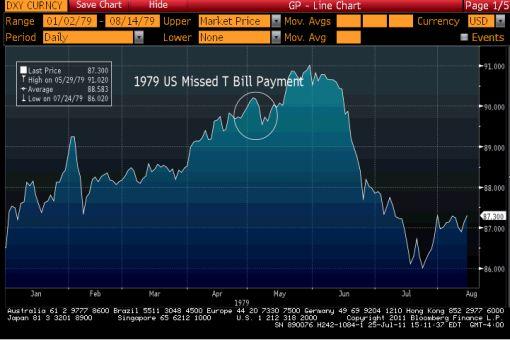Here’s a good perspective on the potential ramifications of the USA missing a bill payment. Kathy Lien posted a story showing the performance of the $USD in 1979 when the USA missed a bill payment. It was a similar environment with lots of politics involved. Of course, the world didn’t end and stocks and bonds were on the verge of multi-decade bull markets:
“Although the U.S. government has never officially defaulted on its debt, it missed payments on some Treasury Bills in 1979. Then as now, Congress was playing a game of chicken with Republicans and Democrats bumping heads on raising the debt ceiling. The debt limit was a fraction of its current levels and at the time, the dollar only fell briefly. The 0.6 percent drop in the Dollar Index was so small that it was barely left an imprint. However less than a month later, double digit inflation and concerns about the outlook for the U.S. economy along with the security of the U.S. dollar drove the greenback sharply lower. It may be tempting to attribute this decline to the short term default on U.S. debt but the Treasury started making its T-bill payments again after a very short delay.
Here’s a chart of how the dollar behaved when the U.S. government missed its debt payment in 1979”:
Mr. Roche is the Founder and Chief Investment Officer of Discipline Funds.Discipline Funds is a low fee financial advisory firm with a focus on helping people be more disciplined with their finances.
He is also the author of Pragmatic Capitalism: What Every Investor Needs to Understand About Money and Finance, Understanding the Modern Monetary System and Understanding Modern Portfolio Construction.


Comments are closed.